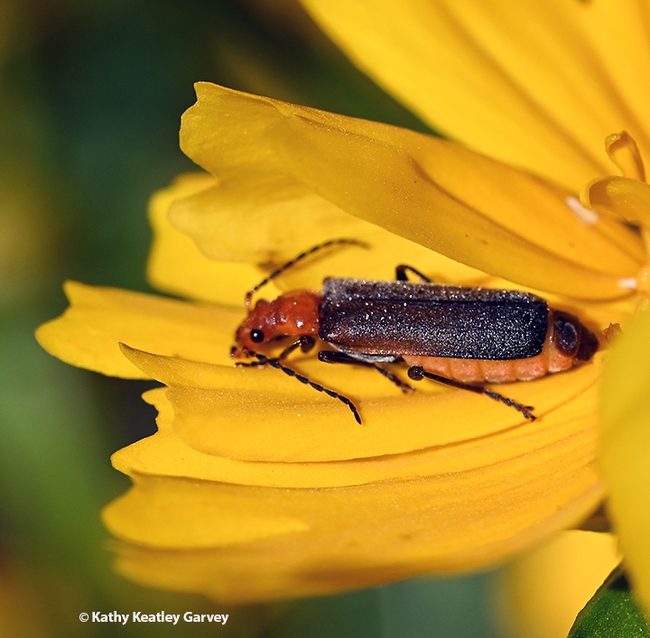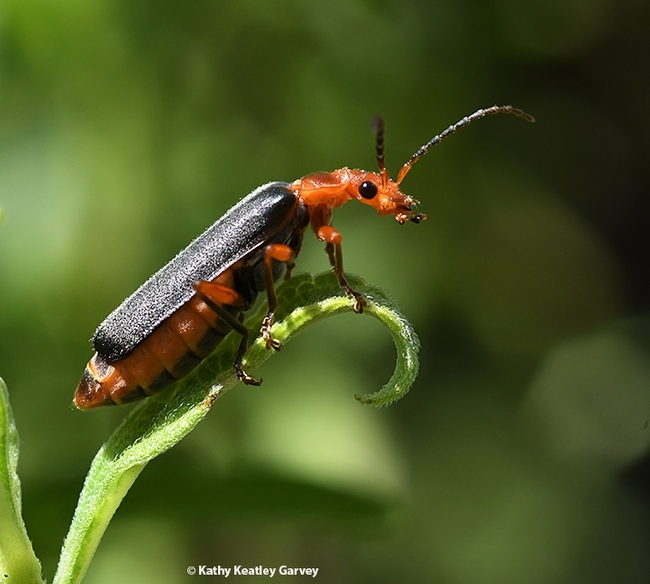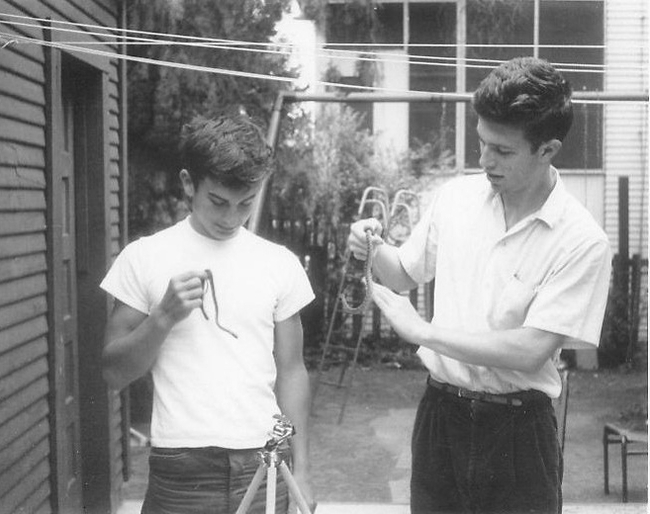- Author: Kathy Keatley Garvey
When you venture into your pollinator garden, look for the beauty, color, diversity and the intensity that surrounds you. You will be astounded.
- A honey bee nectaring on lavender in a soft-pastel scenario.
- A katydid nymph crawling (backlit) on a blanketflower, Gaillardia.
- A Gulf Fritillary butterfly, Agraulis vanillae, nectaring on Lantana
- A praying mantis, Stagmomantis limbata, perched on a Cosmo
- A yellow-faced bumble bee, Bombus vosnesenskii, exiting a lavender patch.
You're the gardener, and you'll be using your garden tools...pruning shears, spade, trowel, garden fork, hoe, hand rake...
But another good garden tool--and an indispensable one--is the camera. You just never know when a buddy shows up in the garden...
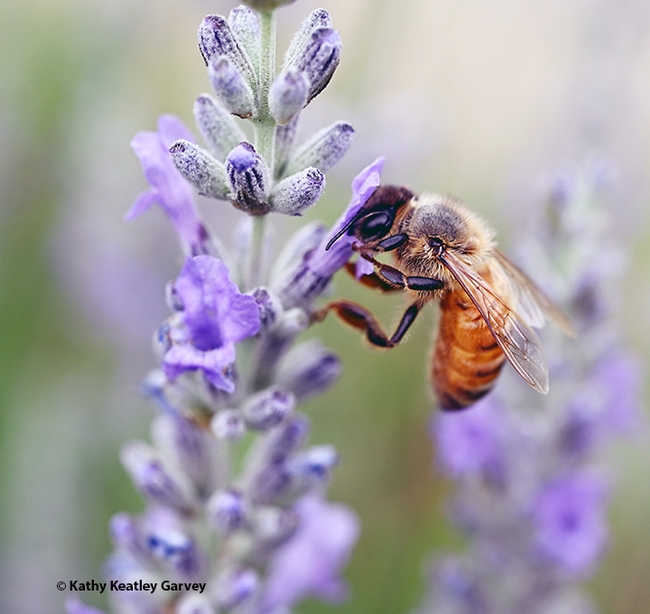
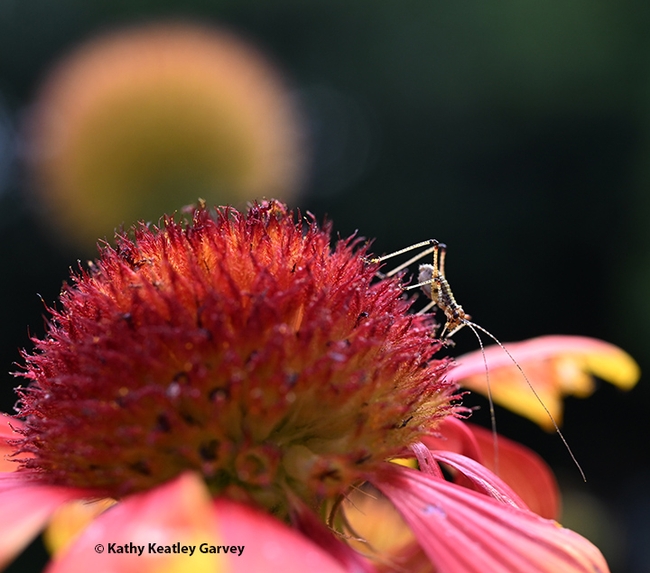
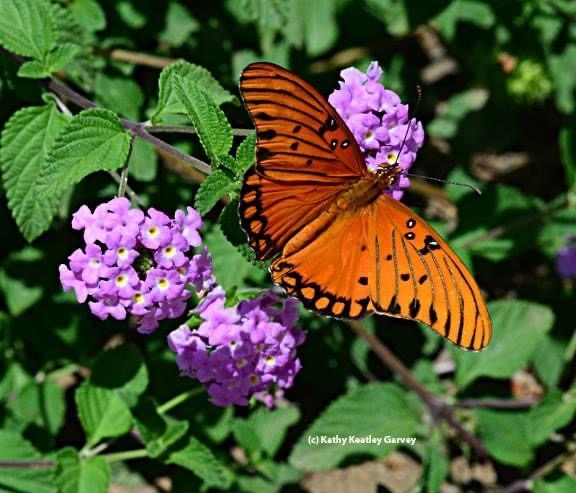
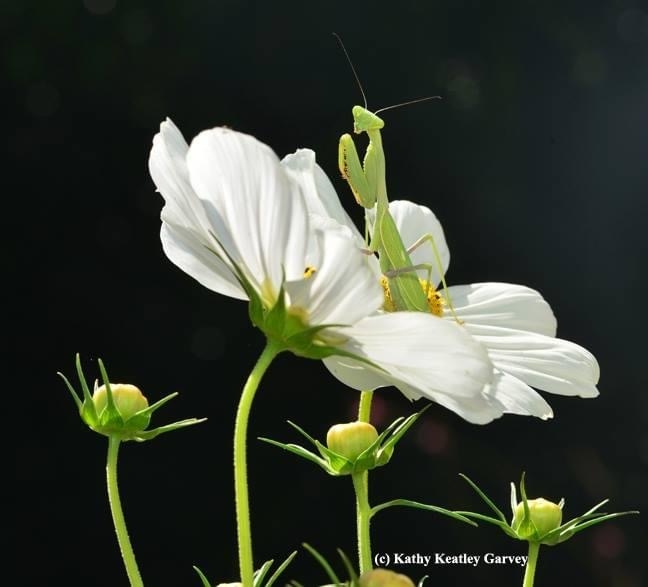
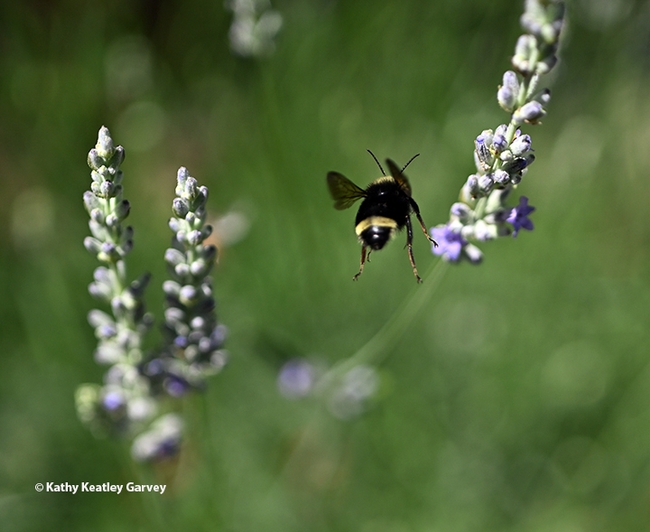
- Author: Kathy Keatley Garvey
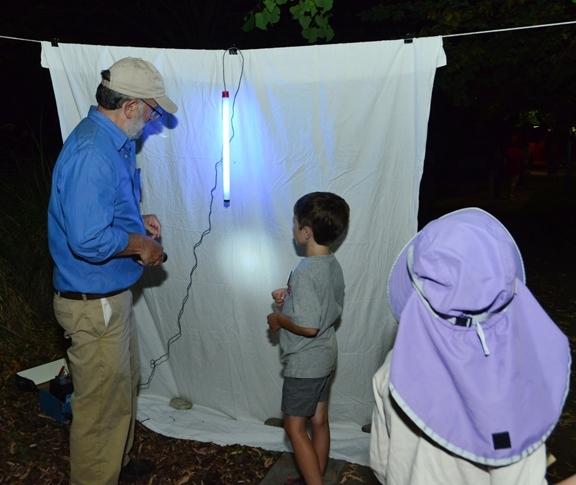
If you attend the Bohart Museum of Entomology's annual Moth Night celebration, affiliated with National Moth Week, you'll meet John De Benedictis, better known as “The Moth Man.”
The indoor-outdoor event, free and open to the public, is set from 7 to 11 p.m., Saturday, July 20 in Room 1124 of the Academic Surge Building, 455 Crocker Lane.
De Benedictis and his colleagues annually set up a blacklighting display, using UV lighting to attract moths and other night-flying insects. He has blacklighted for 37 years.
His moth collection of some 600 species from the Stebbins Cold Canyon Reserve and 300 species from his backyard in Davis is housed in the Bohart Museum.
"Jerry Powell (the late UC Berkeley professor and director of the Essig Museum of Entomology) once estimated that there are about 17,000 North American butterflies and moths," De Benedictus commented. "I would not be surprised if it's closer to 20,000."
'Expertise in Moth Identification Is Invaluable'
"John has been great volunteer and supporter of the Bohart Museum," said UC Davis distinguished emerita professor Lynn Kimsey, former director of the Bohart Museum. "His expertise in moth identification is invaluable and now that Jerry Powell is gone, there's really no one else who can identify moths, particularly little brown moths (LBMs) of California."
De Benedictis, a research associate at the Bohart Museum, is closely linked to UC Berkeley, his alma mater, and UC Davis, where he retired. He holds a bachelor's degree in biology, with an emphasis in entomology (1979), and a master's degree in entomology (1998) from UC Berkeley. "Jerry was my major professor and also recruited me as an undergraduate to work in his lab."
A UC Davis retiree since 2001, De Benedictis worked as a staff research assistant from 1995 to 2001 in the laboratory of medical entomologist Tom Scott, UC Davis Department of Entomology and Nematology.

"I came to Davis in 1989 for a two-month job to key out aphids for Beth Grafton-Cardwell, who at that time was a postdoc of (Professor) Jeffrey Granett. During that time, the rootstock that was being used to protect wine grapevines from grape phylloxera began to fail in Napa and Sonoma counties, so I was able to prolong my stay at Davis through a series of grants to address that problem. While working for Beth and Jeffrey, I got a mini-grant from the former Institute of Ecology to study moths at the Stebbins Cold Canyon Reserve where I collected from 1989 until the last major fire in 2020."
“I began a similar inventory of the species in my backyard after I purchased my home in 1998," De Benedictis said. "It continues to this day, and a synoptic collection of the 300 or so species that I've collected in my yard is housed alongside the Cold Canyon collection in the Bohart Museum.” Grace Horne of the lab of urban landscape entomologist Emily Meineke, Department of Entomology and Nematology, is analyzing the data from these studies as part of her doctoral research.
When Children Were 'Free-Range'
John traces his interest in entomology to his childhood. Born in Oakland in 1945, the second of six children on Aldo and Eleanor De Benedictis, he grew up in Berkeley.
“I am grateful that I had parents who not merely tolerated but encouraged our activities and to have grown up in an era when chickens were confined and children were free-range rather than the reverse as is the case today.”
“I attended Berkeley public schools and later UC Berkeley, except for my last year of junior high school which was in Mt. Vernon, N. Y., while my dad was temporarily transferred,” De Benedictis said. “My older brother Paul was keenly interested in natural history, which switched from subject to subject whenever a new Golden Nature Guide came out. We spent much of our free time poking around in the East Bay Regional Parks and in Strawberry Canyon behind Berkeley's Central Campus.” (Paul went on to obtain a doctorate in ecology in Michigan.)
While in the fourth grade, John began “collecting butterflies, a few flashy moths, and other insects with my older brother and a couple of classmates. A highlight of my youth was the return trip from New York by car where we chased butterflies that we never saw in New York or in California as often as we could complain long and loud enough to make my dad stop the station wagon.”
When John was attending junior high in the late 1950s, he found a Polyphemus moth under a streetlight on the UC Berkeley campus. “It was a highly prized find. At UC Berkeley, we collected on spring field trips with the systematics professors and students and we---whoever was participating--ran lights on during our spruce budworm field trips. I ran a sheet a few times on San Bruno Mountain on my own and was surprised to find that very few of the moths that I had reared from caterpillars flew to my light. While in grad school and afterwards, I went on a few of Jerry Powell's trips to the California Channel Islands to assist him in his inventory of the islands' Lepidoptera species. There we ran lights and set out light traps when it wasn't too cold and windy.”
Species Named for Him
De Benedictis recalled that he and Dave Wagner, now a professor at the University of Connecticut, started graduate studies with Powell at UC Berkeley at the same time. "Jerry had a long-term project studying larval host plants of caterpillars, and Dave and I were among the succession of students who took care of his larval rearing lots on the Berkeley campus. Dave went on to become the current authority on the caterpillars of large moths. I was more interested in smaller moths and prolonged my graduate years by collecting caterpillars on San Bruno Mountain by the San Francisco Airport.” There De Benedictis discovered a handful of new species, one of which Powell named Gnorimoschema debenedictisi.
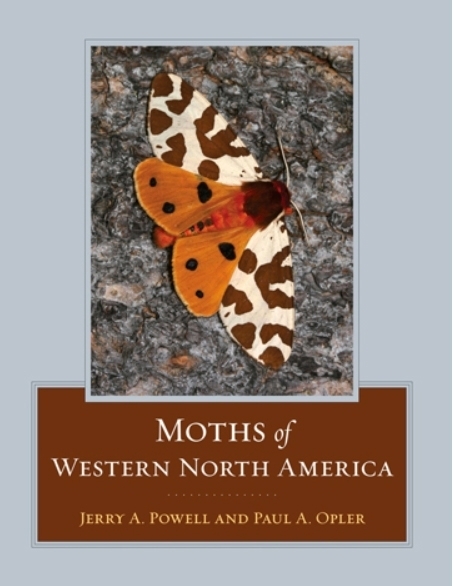
“The Mid-Winter Gathering is a legacy of Jerry Powell,” said De Benedictus, who spent more time in the field with Powell than any other UC Berkeley graduate student. "I was privileged to be Jerry's student and lucky to have him become my friend."I
In a tribute to Powell, the Essig Museum wrote: "Jerry's rearing program was the most extensive in the history of the study of New World Microlepidoptera. For over 50 years he and his students processed more than 15,000 collections of larval or live adult Lepidoptera. Resulting data encompass more than 1,000 species of moths, through rearing either field-collected larvae or those emerging from eggs deposited by females in confinement. This total includes more than 60% of an estimated 1,500 species of Microlepidoptera occurring in California."
Powell and Paul Opler, two Lepidoptera legends, co-authored Moths of Western North America.
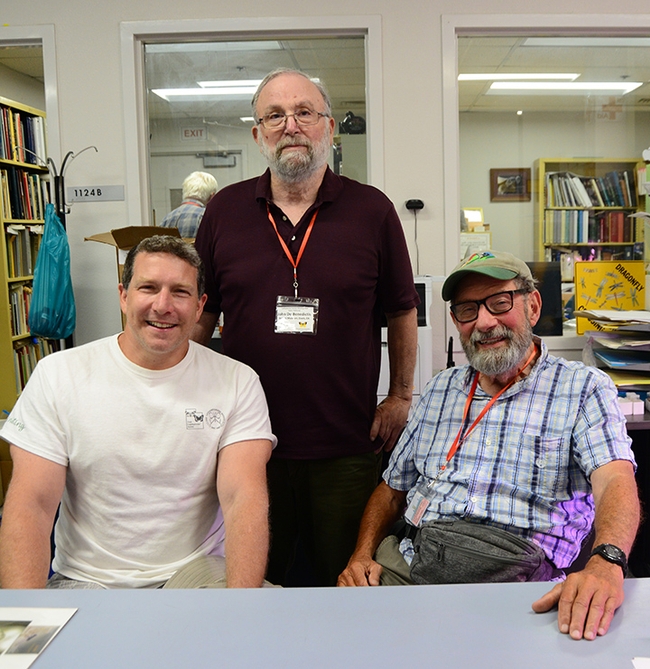
- Author: Kathy Keatley Garvey
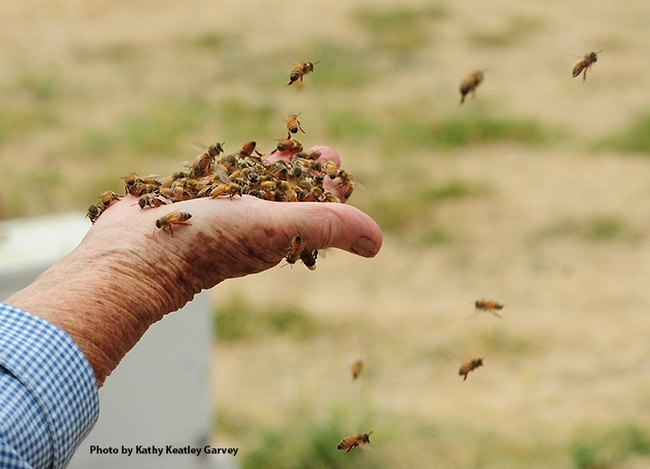
"I have decided I do not want to be the queen bee because she never ever gets to smell the flowers!" the Petaluma resident said. "I would much rather be a worker bee! The queen bee has a short life which I have already avoided, of course, and plan on many more years in the garden."
Ettamarie, in her eighth decade, is a retired teacher who taught school for 37 years, has kept bees for 30 years, and has volunteered as the leader of a 4-H beekeeping project for the past 25 years.
A worker bee, she is!
The Vacaville Museum Children's Party, open to Vacaville children between the ages of 3 and 9, will take place from 10 a.m. to 12:30 p.m. in the museum courtyard at 213 Buck Ave., Vacaville. Tickets, limited to 250, are $3 for children (same price for adults accompanying them). Tickets must be purchased at the museum on Thursdays through Saturdays between 1 p.m. and 4:30 p.m.
Coordinators Pamela King and Diana McLaughlin said the event, themed "Fun on the Farm," will include 4-H animals, a walk-around Mother Goose, face-painting, and a ring toss with a hobby horse named Trigger (the work of Peter Shull and Georganne Gebers), Among the many other activities, the youngsters will create sand art jars, craft paper crowns, plant seeds in a take-home container, and pose for photos behind a Bohart Museum of Entomology dogface butterfly cutout banner. Lunch, on the house, will include hog dogs, popcorn, chips, cookies and water.
But back to Ettamarie Peterson.
“I started beekeeping before I retired in 1998 from 37 years of teaching,” she said. “My teaching career was mostly in special education, following a few years teaching second and first grade. I became one of the first resource teachers in California back in 1980 after getting my master's degree in special education."
Active in the beekeeping industry, Ettamarie has served as president and treasurer of Sonoma County Beekeepers' Association (SCBA) "for many years" and edits the SCBA newsletter, The Monthly Extractor.
She loves "talking bees." She shows her glassed-in bee observation hive at schools and other venues. She collects swarms for her Liberty 4-H Club beekeepers. "I got involved in 4-H when my son wanted his daughters to learn how to keep bees,” she recalled. “They are both parents now so I am hoping to teach the three great-grandsons, too!"
Her interests also include bee photography, raising chickens, growing vegetables. and planting flowers “for the bees and butterflies. My granddaughter and I have a special garden in front of my house for bees and butterflies."
Ettamarie is also a longtime friend and supporter of UC Davis. She delivered a tribute to the late Eric Mussen (1946-2022), a 38-year California Cooperative Extension apiculturist and member of the Department of Entomology and Nematology faculty.
She and her husband, Ray (a non-beekeeper), enjoy life on the Peterson Ranch. "We've been married for 65 years and have 3 children, 9 grandchildren and 12 great grandchildren! What a wonderful life I have!”
Just don't call her a queen bee, please. She'd rather be a worker bee!
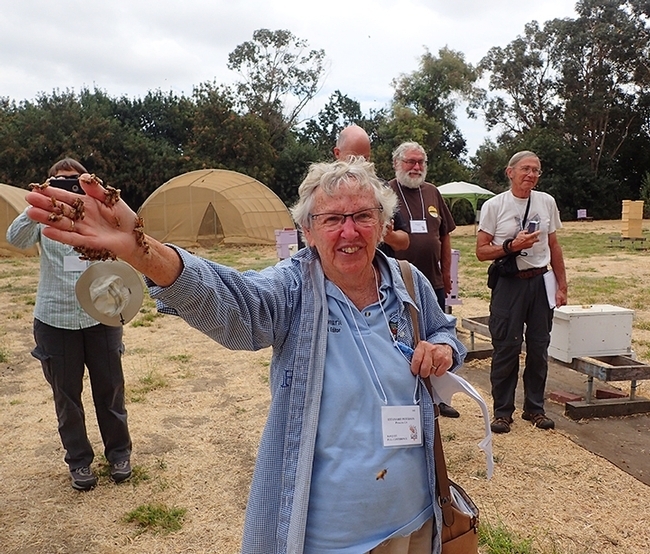
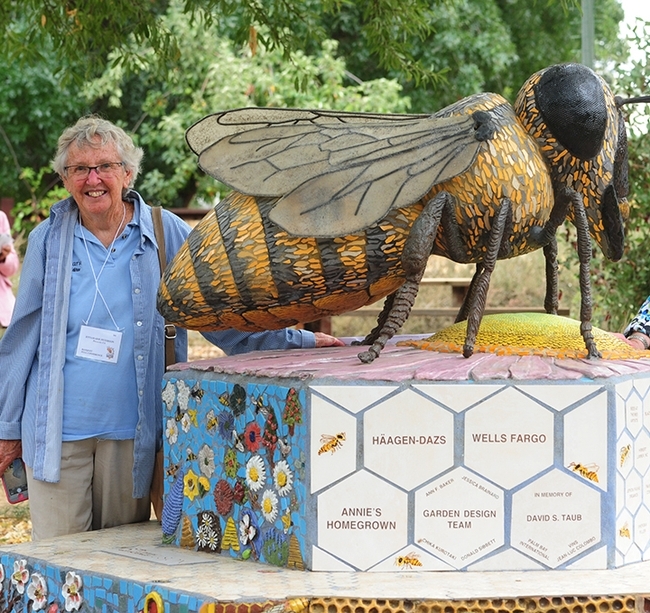
- Author: Kathy Keatley Garvey
One potato, two potato, three potato, four...
You never know what will pop up in a pollinator garden.
Meet Mr. Potato Capsid, Closterotomus norvegicus, often found on nettle, potato, clover and cannabis.
We spotted him (or her) in a Vacaville pollinator garden, where there is no nettle, potato, clover or cannabis. But it also feeds on chrysanthemum, carrots and members of the sunflower family, Asteraceae.
It popped up on a chrysanthemum blossom. The insect is green and probably a nymph as the color changes, when it's an adult, to reddish brown.
It belongs to the family Miridae. Entomologists point out that this family is the largest of true bugs belonging to the suborder Heteroptera.
At first we thought it was a lygus bug, which is also a myrid and a serious pest of cotton, strawberry and alfalfa.
But no, a potato capsid, an insect originating in the Mediterranean region. It prefers to feed on flowers, buds and unripe fruit.
Same family, though.
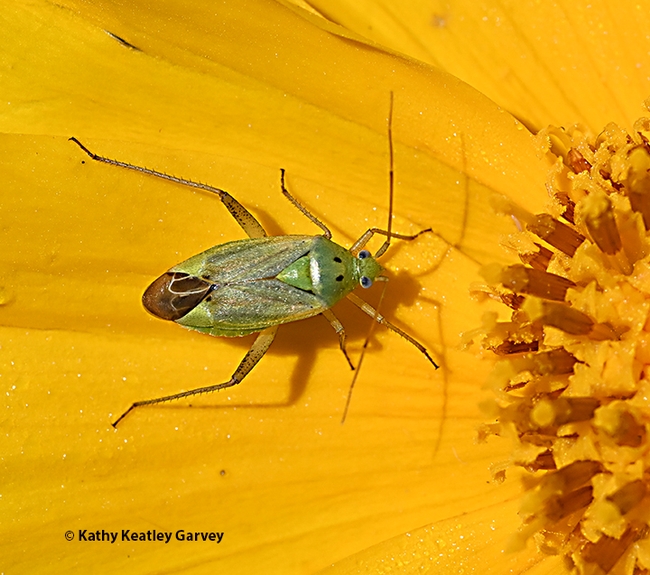
- Author: Kathy Keatley Garvey
It's the Fourth of July and what better time to post images of the aptly name "soldier beetles" than today.
These insects (family Cantharidae) resemble the uniforms of the British soldiers of the American Revolution, which is apparently how their name originated. They're also called "leatherwings" in reference to their soft, leatherylike wing covers.
Like lady beetles, aka ladybugs, these soldier beetles make short work of aphids and other soft-bodied insects. We've seen them devour so many aphids on our plants that they should be awarded the Aphid Belt, similar to Joey Chestnut's famed Mustard Belt.
Indeed, soldier beetles are eating machines, just like Joey.
Wikipedia describes Joey Chestnut (who, by the way, grew up in Vallejo, Solano County), as an "American competitive eater" ranked No. 1 in the world by Major League Eating. In addition to hot dog-eating contests, Chestnut has won contests devouring pizza, wontons, chicken wings, and corned beef sandwiches. And even poutine (french fries and cheese curds, topped with brown gravy).
No aphids, yet, though. Not even sprinkled on pizza slices.
